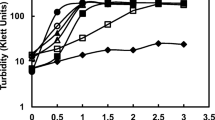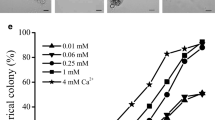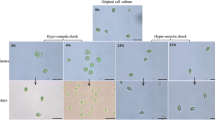Abstract
A mutant of Dunaliella tertiolecta produced by treatment with methyl nitrosoguanidine and designated HL25/8, grew more slowly than the parent strain under all experimental conditions and was conspicuously less tolerant of NaCl. Total photosynthetic activity (C-fixation and O2 evolution) was less in HL25/8 than in the parent strain and was affected differently by [NaCl] in the two strains. Various growth characteristics indicated that the mutant had a greater need than the parent strain for CO2 as distinct from HCO −3 as a source of carbon. Gaseous CO2 extended the range of salt tolerance of the mutant. For example, HL25/8 could not sustain growth at 1.02 M NaCl in a conventional buffered medium containing bicarbonate as the sole carbon source but could do so if the medium were sparged with a CO2/air mixture. The mutant strain has a lower activity of carbonic anhydrase on the cell surface than the parent D. tertiolecta. Moreover, the two strains differ sharply in the responses of their surface carbonic anhydrase activity to salinity of the growth medium. Increasing sodium chloride concentration above 0.17 M raised activity of the enzyme in the parent strain but decreased it in HL25/8. We conclude that the low activity of carbonic anhydrase and its response to salinity can largely, but perhaps not fully, explain the diminished salt tolerance of the mutant. A plate counting method applicable to Dunaliella is described.
Similar content being viewed by others

References
Aizawa K, Nakamura Y, Miyachi S (1985) Variation of phosphoenolpyruvate carboxylase activity in Dunaliella associated with changes in atmospheric CO2 concentration. Plant Cell Physiol 26:1199–1203
Aizawa K, Tsuzuki M, Miyachi S (1986) Kinetic studies on the active species of inorganic carbon absorbed by the cells of Dunaliella tertiolecta. Plant Cell Physiol 27:37–47
Borowitzka LJ, Brown AD (1974) The salt relations of marine and halophilic species of the unicellular alga Dunaliella. The role of glycerol as a compatible solute. Arch Microbiol 96:37–52
Brown AD (1976) Microbial water stress. Bacteriol Rev 40:803–846
Brown AD, Borowitzka LJ (1979) Halotolerance of Dunaliella. In: Levandowsky M, Hutner SH (eds) Biochemistry and physiology of protozoa, vol 1. Academic Press, New York, pp 139–190
Brown AD, Lilley RMcC, Marengo T (1982) Osmoregulation in Dunaliella. Intracellular distribution of enzymes of glycerol metabolism. Z Naturforsch 37C:1115–1123
Delieu T, Walker DA (1972) An improved cathode for the measurement of photosynthetic oxygen evolution by isolated chloroplasts. New Phytol 71:201–225
Gimmler H, Lotter G (1982) The intracellular distribution of enzymes of the glycerol cycle in the unicellular alga Dunaliella parva. Z Naturforsch 37C:1107–1114
Goyal A, Lilley RMcC, Brown AD (1986) The size and turnover of the glycerol pool in Dunaliella. Plant Cell Environment 9:707–710
Johnson MK, Johnson EJ, MacElroy RD, Speer HL, Bruff BS (1968) Effects of salts on the halophilic alga Dunaliella viridis. J Bacteriol 95:1461–1468
Latorella AH, Vadas RL (1973) Salinity adaptation by Dunaliella tertiolecta. 1. Increases in carbonic anhydrase activity and evidence for a light-dependent Na+/H+ exchange. J Phycol 9:273–277
Lowry OH, Rosebrough NJ, Farr AL, Randall RJ (1951) Protein measurement with the Folin phenol reagent. J Biol Chem 193:265–275
Miyachi S, Tsuzuki M, Avramova ST (1983) Utilization modes of inorganic carbon for photosynthesis in various species of Chlorella. Plant Cell Physiol 24:441–451
Umbreit NW, Burris RH, Stauffer JF (1949) Manometric techniques and tissue metabolism. Burgess Publishing Co., Minneapolis
Walker DA (1971) Chloroplasts (and grana): aqueous (including high carbon fixation ability). Meth Enzymol 23:211–220
Wegmann K (1979) Biochemische Anpassung von Dunaliella an wechselnde Salinität und Temperatur. Ber Deutsch Bot Ges 92:43–54
Wilbur KM, Anderson NG (1948) Electrometric and colorimetric determination of carbonic anhydrase. J Biol Chem 176:147–154
Author information
Authors and Affiliations
Rights and permissions
About this article
Cite this article
Brown, A.D., Goyal, A., Larsen, H. et al. A salt-sensitive mutant of Dunaliella tertiolecta . Arch. Microbiol. 147, 309–314 (1987). https://doi.org/10.1007/BF00406125
Received:
Accepted:
Issue Date:
DOI: https://doi.org/10.1007/BF00406125



